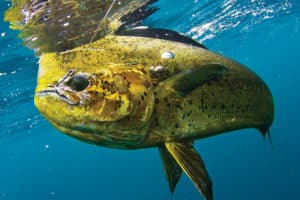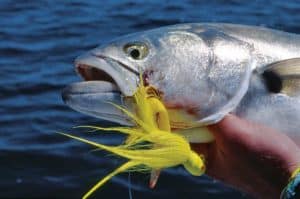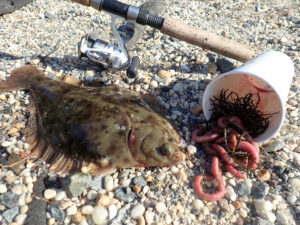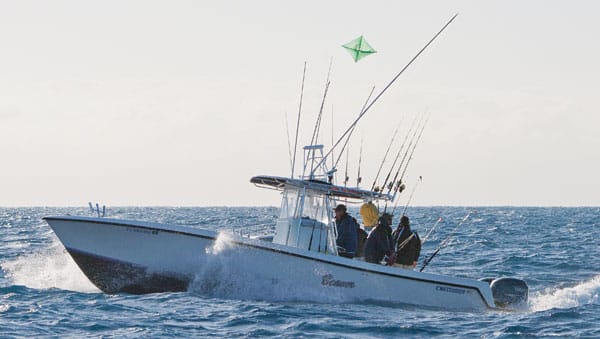
| |Kite-fishing is a visual game, and learning to push your boat to its maximum capabilities while not fouling kites and baits will lead to greater success. (Pat Ford)|
Whether you’re pursuing sailfish in South Florida or bluefin tuna off the Massachusetts coast, kite-fishing often produces when other techniques will not. Dangling multiple baits atop the water’s surface generates both stealth and the sheer power of numbers.
But kite-fishing can be tricky, especially for beginners, and particularly when flying two kites. There’s a lot going on at any given moment, and great attention must be paid to baits, lines, wind and current.
Then there’s your boat.
No doubt that maneuvering can get dicey with all that hardware in the air. But it’s something that boat anglers must become adept at if they hope to become successful kite-fishermen.
Spreading the Lines
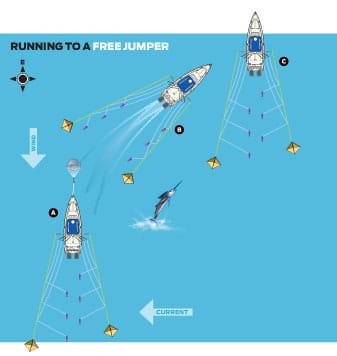
| |** When drifting in an easterly breeze and spotting a free-jumping sailfish ahead and starboard of his boat , A. Capt. Dean Panos pulls in his sea anchor, raises his kite baits from the water and runs ahead and around the fish’s path . B. When he feels he has intercepted the sailfish, he reorients the boat into the wind and drops the baits back into the water.** C. (David Sheperd)****|
Big sport-fishers or outrigger-equipped, dual‑engine center consoles offer a captain optimum mobility when flying two kites from the stern. Why? The port and starboard kite lines are generally run through the boat’s corresponding outriggers, which keep the kites spaced well apart in the air.
“This allows you to turn the boat right or left without having to worry about the kites tangling,” says Capt. Dean Panos, who runs the Double D, a 34-foot Sea-Vee, out of Miami. “It also allows you to spin the boat without gnarling up your rigs.”
Wind speed generally dictates just how aggressively the boat can be turned. “With anything greater than 15 knots, you can do whatever you want,” Panos says. “But with light wind, you’ll often have to power forward and then to the side to keep things orderly.”
But what if you don’t own a boat with outriggers? Don’t fret — you can still fly dual kites. But it must be done more carefully.
Capt. Dave Kostyo has been doing so for years out of Miami aboard his 28-foot Whitewater, Knot Nancy. His boat is not equipped with outriggers, so Kostyo instead runs his kite lines through stainless steel rings attached to the port and starboard sides of his boat’s T-top.
“It gets the lines up a little higher and spreads them out a bit,” he says. “I’ve got to be careful about trying to spin like the bigger boats because I don’t have the strength of structure up top nor the width. But it can be done — and the more you practice, the better you get.”
Running and Gunning
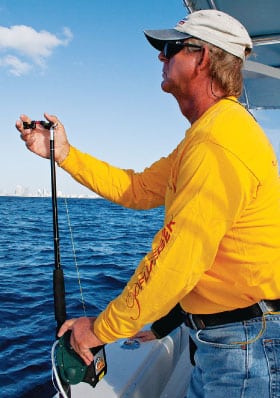
| |To help keep his baits spread out, Capt. Dave Kostyo runs his kite lines from the kite rod through stainless steel rings attached to the port and starboard sides of his boat’s T-top. (Mike Mazur)|
That’s good advice for new kite-fishermen — and, similarly, Kostyo says it’s important for anglers new to this type of fishing to remain “one step ahead of the curve” in regard to boat positioning.
“You’ve got to think ahead of what’s currently happening,” he says. “For instance, don’t react to what the fish has done but instead of what the fish is on the verge of doing.”
This certainly applies to boat-handling when fighting a fish — but also when searching for them.
“Kite-fishing is very visual,” Panos says. “In addition to watching the baits, I’m constantly watching the horizon for fish on the surface.”
If Panos spots a free-jumping sailfish out ahead of the boat, he’ll holler for his crew to pull in the sea anchor and raise the baits.
It takes a good deckhand about 30 seconds to rip in the sea anchor, and the baits typically can survive for about 30 seconds to a minute while suspended in the air, Panos says. Then he juices the engines to cut off the moving fish.
“We run with the kites and baits in the air,” he says. “Nothing crazy that will break the kites off, but pretty hard, 15 to 18 mph, depending on how hard the wind is blowing.”
It’s important to stay on a heading into the breeze so the kites don’t crash. Once Panos gets around the fish, he straightens out the boat and drops the baits — hopefully on one or more fish.
Orderly Catches
This sort of run-and-gun kite-fishing is common in high-stakes sailfish tournament fishing — but Kostyo often takes a more subtle approach.
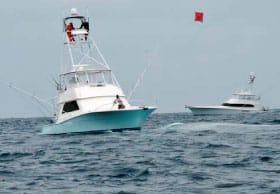
| |Efficient maneuvering of big boats in crowded waters is a requirement when flying kites. (Capt. Vincent Daniello)|
“When moving to different depths, a lot of guys like to pick up everything and run, but I get lots of hits simply by moving out slowly to the new depth,” he says.
Kostyo says it’s important for anglers to have a keen understanding of how wind and current affect a particular boat. “There are days I can use just one engine and other days when I need both engines in gear to keep the bow into the wind,” he says. “You really have to be in tune with your boat.”
And once hooked up, staying in tune with the fish from the helm becomes essential too.
“Always try to keep ahead of the fish,” Kostyo says. “Try to keep it off the stern or parallel to the cockpit. The guys with outriggers can spin the boat more easily, and they’re able to keep the stern facing the fish and back down on it. But for me, without outriggers, you just keep the fish to the rear of the cockpit and move forward with it.
“It all comes down to practice, though,” Kostyo says again for emphasis. “And the more you do it, the better you get.”
| About The Experts |

|

| |One of the top kite-fishing captains in Miami, Capt. Dean Panos runs a 34-foot Sea-Vee, the Double D. Call 954-805-8231 or visit doubledcharters.com.| Capt. Dave Kostyo has been chartering his 28-foot Whitewater, Knot Nancy, in the Miami area for 20 years. Call 305-965-9454 or visit knotnancy.com.|

